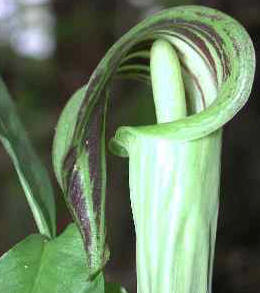Where does Jack live?
As you can see from this map put together by the USDA's Plants Database, Arisaema triphyllum can be found in the eastern half of the United States and Canada. Its immediate surroundings generally include deciduous forests, swamps, and other types of wetlands.
Jack-in-the-pulpits are found in neutral to acidic soils, which can range from a minimum pH of 4.8 to a maximum of 7.0. They have little drought tolerance and no salinity tolerance; but they can withstand relatively low temperatures, as much as-18°F(-28°C). Jack-in-the-pulpits also require partial shade, just like another organism living in some of the same areas, the sweet violet(Viola odorata).
A variety of other organisms can be found
in the same areas as the jack-in-the-pulpit.
These can include
deer(Odocoileus virginanus) and
other organisms that eat the
jack-in-the-pulpit, ranging from birds like
wood thrushes to
mosquitoes(Anopheles earlei) and other
insects.
 Other
birds that may live in the same moist
forests as the jack-in-the-pulpit are the
Canadian goose(Branta canadensis),
and the
mallard(Anas platyrhynchos).
To learn more about the way the
jack-in-the-pulpit interacts with the other
organisms in its environment, follow this
link to the
interactions page.
Other
birds that may live in the same moist
forests as the jack-in-the-pulpit are the
Canadian goose(Branta canadensis),
and the
mallard(Anas platyrhynchos).
To learn more about the way the
jack-in-the-pulpit interacts with the other
organisms in its environment, follow this
link to the
interactions page.
Like many other plants, the jack-in-the-pulpit's niche is directly related to its ability to use photosynthesis. To read more about this ability, check out the nutrition page. In order to use photosynthesis to create energy, the jack-in-the-pulpit requires carbon dioxide. Lucky for it, many organisms produce CO2 as a waste product and release it when they exhale. These same organisms need oxygen to survive, and fortunately the jack-in-the-pulpit and other plants release O2 as a waste product when they photosynthesize.

